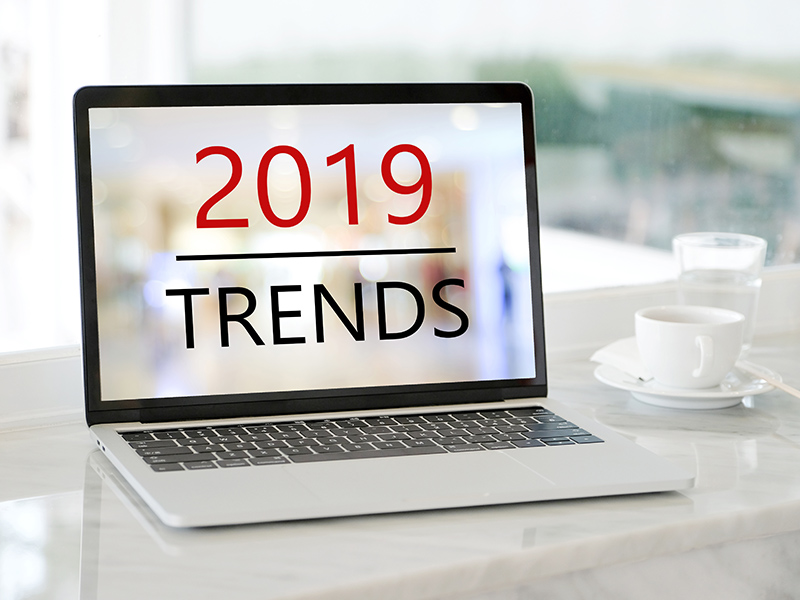As the end of 2018 approaches and the dawn of a new year is on the horizon, we think it’s the perfect time to think about how our websites hold up to the modern trends. While some web design concepts are nearly timeless, most trends change, evolve, or are outright replaced as time goes on, and as the web becomes more and more central to our daily lives the importance of a relevant, contemporary website only increases.
With that in mind, we’ve spent some time researching 7 of the most promising web design trends to keep an eye on as 2019 unfolds. You might recognize a few familiar faces in the details! This year has been an influential year, and some of the rising trends of 2018 are evolving before our very eyes. Have a look for yourself:

1. A Focus on Mobile and Seamless Experience
The increasing popularity of web browsing on mobile may just be the north star by which web developers can navigate the future of their craft and trade. From a statistical perspective, mobile has come to dominate nearly every aspect of online life. From shopping to web browsing and internet-based communication, mobile users represent the majority. Their dominance of online markets means that designing your website to be mobile-friendly while offering a seamless PC-to-Mobile experience is absolutely vital going into 2019.
2. Asymmetrical Grids
The grid layout has been an increasingly popular facet of website design in the last half-decade or so, but there’s a new form of it that is rising to the top of design trends. The “asymmetrical grid” style makes a seemingly minor change to grid-style design that results in an incredible aesthetic effect, blending the cleanliness and clarity of the grid-style with the inviting and bold look of asymmetric design. The asymmetrical grid also grants itself well to another currently-popular design trend, which we’ll explore below.

3. Single-Page Simplicity
Single-page design, also sometimes referred to as continuous feed design, has been around in some form for years. It’s newest iterations, however, have totally changed the experience most people experience on the web – for the better. Popularized by websites like Twitter and Facebook, the single-page style of perpetually-new content has been adopted by major players in nearly every niche of the internet. From journalistic outlets that serve up their curated content in a continuous feed by release time to eCommerce stores that utilize big data insights to recommend lists of items to their customers, the single-page design style is evolving faster than any could have predicted.

4. User-Friendly Advertising
One of the biggest changes the internet experienced in 2018 was the introduction of the EU’s General Data Protection Regulation, or GDPR. This sweeping regulatory update changed so much about the way data will be used going forward that it’s hard to summarize. One related side-effect of this legislation that will have an impact on web design, however, was a major public reanalysis of ad space and ad usage.
In recent years, advertisements have become more targeted, customized, and pervasive, which has led to the rise of wholesale ad blockers that can completely decimate the layout of a website, not to mention its profitability! In an effort to reform online advertising, consumer groups, advertising firms, and even major search engines have conducted extensive research to identify what types of ads coexist best with user experiences.
In 2019, you can expect new ad formats that fit more naturally with the content they coexist with. Gone are the days of pop-up ads and auto-playing videos.
5. Stylization
One of the trends that is rising across multiple fields of media is a turn towards more stylized design. Interestingly enough, a fantastic example of this trend can be found by looking at some of the most successful films of this year. Many of them have these traits in common: Bold, radiant colors and unrestricted personality. The same trend is undeniably on the way for web design as well.
Internet denizens are tired of drab, gray, cookie-cutter websites. They want to see originality, creative use of color, and, most of all, what makes your brand special. Stand out! Genuinity is what’s in.
6. Snappiness
Snappiness is a concept that all of us have experienced but may not always be able to explain if asked. Snappiness refers to how it feels to use a website. Sites with greatly varied core designs can both be snappy in different ways. For example, a complex browser-based mathematics calculation site might have snappiness in the form of clear navigation and quickly-loading graphics, while the website of a designer clothes brand might have snappiness in the form of brilliantly ornate animations that run smoothly on mobile.
Snappiness often boils down to quality back-end design and forward-thinking about your viewer base or customer base. Loading your site with videos, for example, when your customers mainly access on mobile would likely detract from the snappiness of your site, since it would bog down their connections with heavy data usage.
7. A Focus on Privacy
As major consumer data breaches have taken the spotlight in the world of cybersecurity, more and more web users and website owners have become aware of the great risks that lax data privacy policies can pose, both to the safety of essential data and the reputations of major firms. In 2019, you can expect to see data privacy becoming a major concern for a greater share of web users, and it’s important that sites build in data privacy as a part of their design. Using safe, updated tools and phasing out older ones (like Flash in many cases) is vital but so, too, is communicating the privacy steps your website takes to your users.
Put privacy front and center, and make it easy for your users to locate information about the steps your site takes to protect their privacy. Your users will thank you, and you’ll end up beating a lot of your competitors to the punch in 2019.
